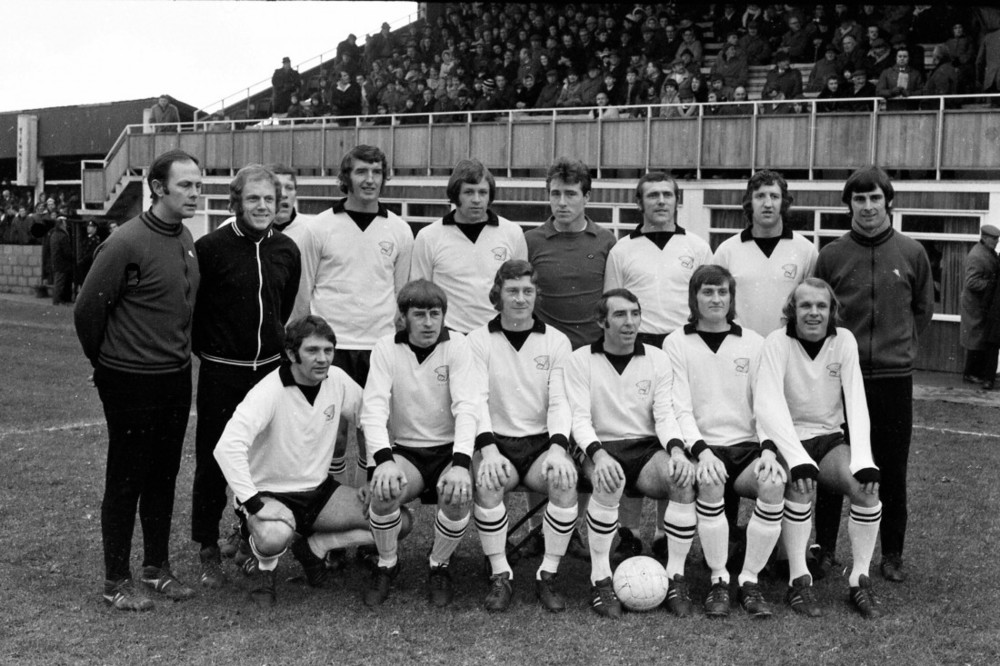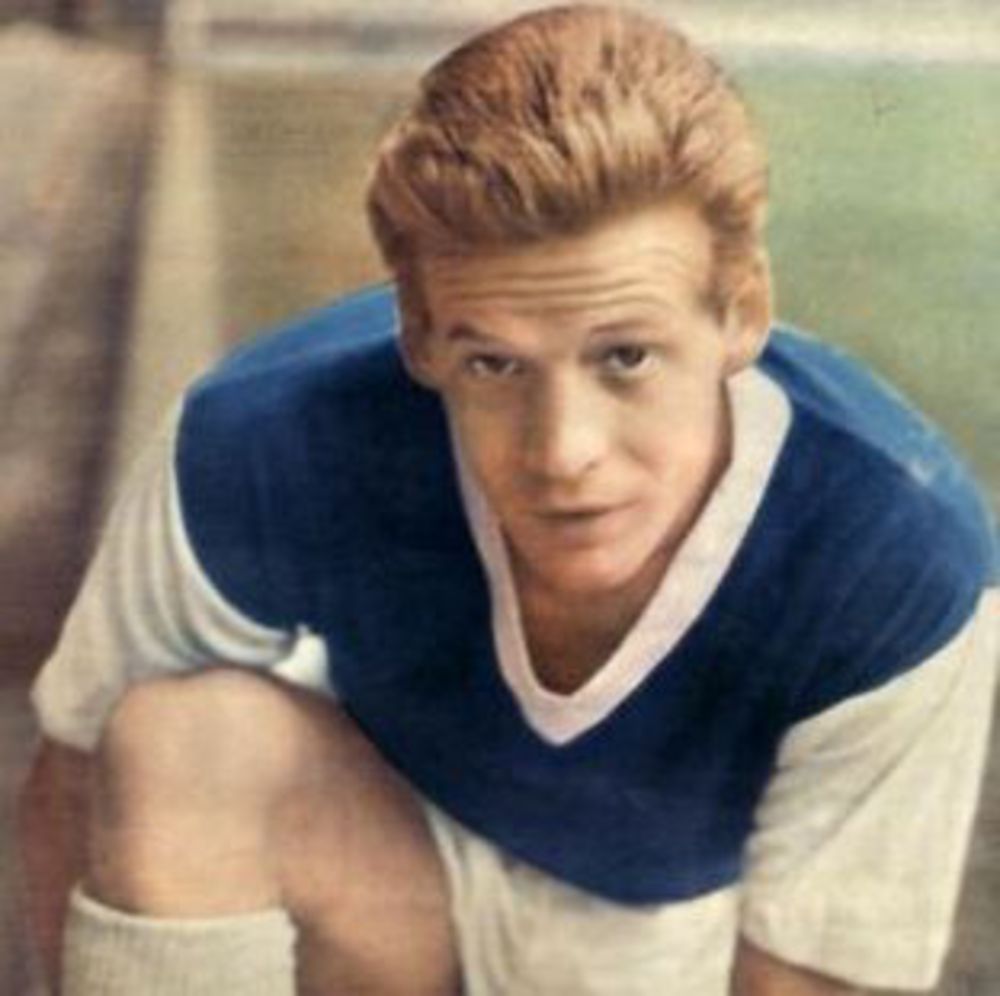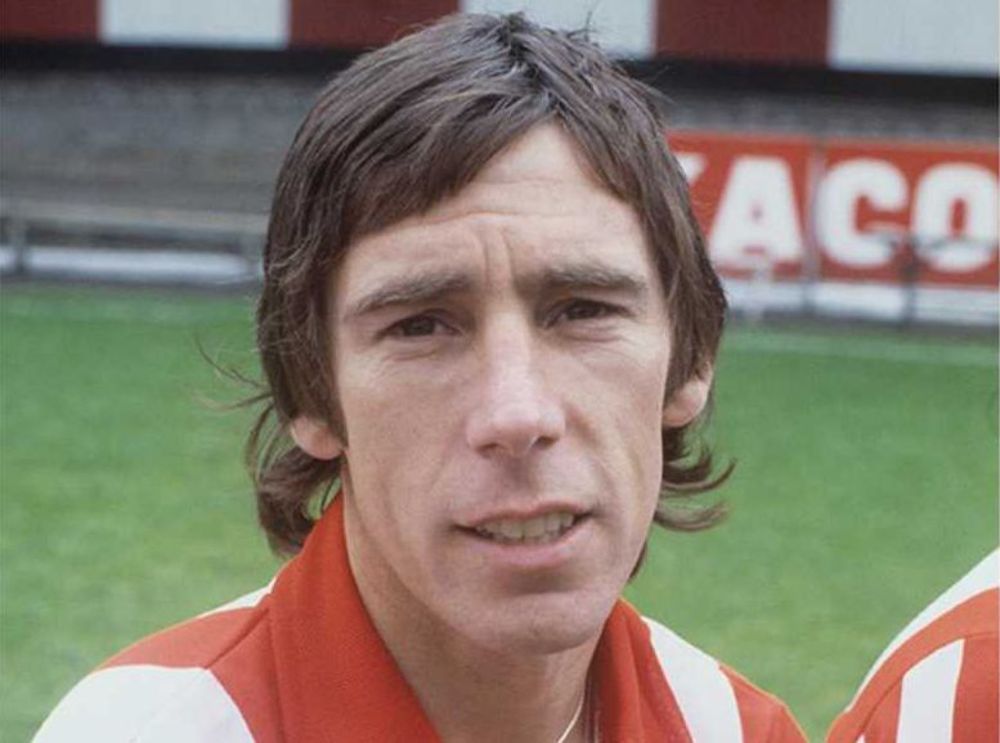
Fred Potter with Hereford team
Centre forward JOHN O’ROURKE is a rare breed in that he was considered something of a cult hero at just about every one of his former clubs.
His youth career was spent with Arsenal and then he signed as a young professional with Chelsea in 1962.
He failed to make the senior side at Stamford Bridge and moved on to Luton Town in December 1963, where he topped the Hatters’ goalscoring charts in three consecutive seasons.

After a terrific record of 64 goals in 84 games, O`Rourke (left) was sold to Middlesbrough in July 1966 for £20,000 and netted twice on his debut at Colchester United, going on to score 30 goals to help the club to win promotion from the old Division Three in 1966/67.
This included a hat-trick in the crucial final match of the season - a 4-1 victory over Oxford United which earned him a place in the club's `Hall of Fame`.
In February 1968, he moved to Ipswich Town for £30,000 and helped the Tractor Boys clinch the Second Division title that season.
After 69 games and 30 goals for Ipswich, he was sold to Coventry City for £80,000 and here he became a key figure as the Sky Blues qualified for the UEFA Fairs Cup in 1969/70.
From there he joined Queens Park Rangers for £70,000 in October 1971, featuring in the 1972/73 promotion-winning campaign, before moving to AFC Bournemouth for £35,000 in January 1974.
He scored 4 goals in 22 league outings with the Cherries before heading to Southern League Premier Division side Weymouth in 1976 after a spell in South Africa with Rangers Johannesburg.
Whilst with the Terras, O`Rourke occasionally played alongside former West Bromwich Albion and England centre-forward Jeff Astle.
In 1977, O`Rourke moved along the coast to sign for another Southern League side, Poole Town, where he had been on loan from Bournemouth in October 1975.
A short spell with the Dolphins was followed by three years with league rivals Dorchester Town.
He returned to Poole in 1980 and once he finally ended his playing career in 1981, he then ran the newsagents on the south coast at Highcliffe, near Bournemouth.
STEVE TATE was a prolific goalscorer in non-League football.
Originally an apprentice at AFC Bournemouth, he first came to prominence with Salisbury in the Southern League South Division.
He then played in the Wessex League for AFC Lymington before returning to the Southern League with Bashley and then Havant Town.
He moved to Waterlooville in 1993 for a record £7,000 fee and was the top scorer for several seasons.
He then played for the newly merged Havant & Waterlooville club before moving to the Isle of Wight to play and then later manage Newport, who were then in the Southern League Division One South.
ROY KIRK was spotted playing for Bolsover Colliery and signed for Leeds United in October 1948.
Maybe arriving at the same time as John Charles did not enhance his chances at centre-half, but he took it in his stride.
Leeds experimented with Charles as a centre-forward and Kirk was the regular choice centre-half until Christmas in the following season, then in January and February, he was given the outside right or centre forward role as Charles once more moved to defence.
In March 1952, a £10,000 transfer took Kirk to Second Division Coventry City, but he could do little to prevent the Sky Blues from relegation to Division Three (South) at the end of the 1951/52 season.
At Coventry, he had the unwanted distinction of scoring two own-goals in a match, against in a 2-2 home draw with Leyton Orient in September 1954.
He did, however, create a more favourable record with a goal from 80 yards in November 1954 which proved to be the only goal of the match at the County Ground as Coventry beat Northampton Town in an FA Cup First Round tie.
He stayed at Highfield Road for nine seasons and scored 6 goals in 330 League appearances.
He joined Southern League Division One side Cambridge United in June 1960 as a player and helped them to promotion to the Premier Division in his first season.
He became caretaker manager in 1963 after Alan Moore left the club was appointed manager in August 1964 until 31st May 1966, helping lay the foundations of the club which Bill Leivers got into the Football League.
He died in 1983 aged just 54.

DON ROPER (right) enjoyed a long and successful career with Arsenal.
The winger started out at local club Southampton during the Second World War, before excelling in Division Two in the first post-war league season.
Then-Arsenal manager Tom Whittaker had paid several visits to watch Roper in action and made his move for the talented forward in the summer of 1947.
Roper arrived at Highbury with a reputation for goals and delivered exactly that in his 321 starts for the club.
He scored 95 times in just less than 10 years, narrowly missing out on entry to the prestigious '100 Club'.
In his first season, Roper helped Arsenal to the 1947/48 Division One title, laying on goals for the lethal Ronnie Rooke – later to manage Bedford Town in the Southern League - and scoring 10 times himself.
He switched to the left-wing in the following season but was displaced briefly by Dennis Compton in the Gunners' FA Cup-winning campaign of 1950.
Roper quickly forced his way back into the first team, featuring heavily during the next two seasons.
He earned international recognition with England 'B' in 1953 and played once for the Football League in the same year.
Roper returned to former club Southampton in January 1957 and played 80 games for the Saints, netting 32 goals.
After leaving The Dell, the now 36-year-old Roper continued to play and signed for Southern League Premier Division side Weymouth.
Under Arthur Coles, the Terras finished third in 59/60, with Roper scoring 10 goals in his 33 games before making the move to Dorchester Town the following season, scoring 31 times in just over 100 games for the Magpies.
He passed away in 2001, aged 78.

TERRY DYSON (left) was one of the most famous players to have donned a Wealdstone shirt.
Of course, the likes of Stuart Pearce came later, but he made his name after leaving the Stones.
Dyson had been part of the famous Tottenham Hotspur `double` winning side of 1961 and scored twice in that club’s victory over Atletico Madrid in the European Cup Winners Cup Final of 1963.
He actually started his career in non-League football, playing for Scarborough in the old Midland League.
And at the age of 20, he was snapped up by Spurs, whose manager at the time was Jimmy Anderson.
But it was under his successor, Bill Nicholson, that Dyson`s career thrived, going on to make 184 appearances and score 41 goals.
After leaving White Hart Lane, he had 23 games for Fulham and then 56 for Colchester United before returning to non-League football at the age of 36 with Guildford City.
He helped City to promotion from the Southern League Division One before moving back to North London and joining Wealdstone.
Again, he helped his side to promotion from the Southern League Division One South and stayed until 1976, making 117 appearances and scoring 11 goals.
He retired from playing seriously at the age of 41 but after leaving Wealdstone he became assistant manager at Dagenham, who he helped become the first Southern-based winners of the FA Trophy in 1980.
Managerial jobs at Boreham Wood, Kingsbury Town and Ruislip followed and he worked as a coach for the Inner London Education Authority at Hampstead School.

Right-winger BILLY HAILS (right) started his career with Lincoln City, firstly as an amateur and then as a part-time professional whilst working as an electrician.
After two seasons he joined Peterborough United - then a Midland League club - spending eight seasons at London Road playing over 318 games and scoring 114 goals, helping the Posh into the Football League.
He moved to Northampton Town where he earned a Division Three title winners` medal.
In the summer of 1965, Hails was appointed as player/assistant manager at Southern League Premier Division Nuneaton Borough.
The then 29-year-old was appointed by Boro on a full-time basis, helping general manager Fred Badham with the daily draw competition and with coaching.
He continued in that role after Badham was moved `upstairs` to concentrate on raising funds for the club and the appointment of Dudley Kernick as manager until the summer of 1967 when he was offered the player-manager`s role at Southern League Division One side Rugby Town.
Hails returned to coach at Peterborough for several seasons, even having a short spell as caretaker manager.
Then in 1979, he joined Watford under Graham Taylor as a physiotherapist - a position he held for eight years.
Skilful schemer NEIL MATTHAMS was released by Sunderland in 1965 at the age of 16.
He went on to played in the Northern League for Shildon and Bishop Auckland for six seasons.
He won four County caps for Durham and four England Youth international caps, playing at Coventry City`s Highfield Road against Wales and at Glasgow Rangers` Ibrox against Scotland.
However, at the age of 23, he moved south from Sunderland to Wigston in Leicestershire to start a teaching post in Loughborough.
Wanting to continue to play at the highest possible level, he drove to George Street after reading about Enderby Town in the local Leicester Mercury newspaper.
After one training session, then-Enderby manager Dougie Brews immediately recognised his talent and he signed for the Southern League Division One North club.
He left Enderby three times - the first two occasions due to the club's perilous financial position - but returned twice.
He signed for Nuneaton Borough in early December 1974 for a £1,000 fee.
He returned to Enderby in the summer of 1976 after being released by Boro and then played for Shepshed Charterhouse before re-joining Enderby for the final time – playing in their first season as Leicester United before retiring from the game at the age of 39.
Remarkably, FRED POTTER (pictured with the Hereford United team) began his career as an inside right and only became a goalkeeper by pure chance.
He was playing for Halesowen Town in the Birmingham League when he came to Aston Villa's attention and they subsequently signed him as an amateur.
He made his debut for Villa's sixth XI team and scored five times which earned him a rapid promotion to the thirds.
But his playing career turned one cold Boxing Day at Lye Town when Villa`s Scottish international goalkeeper Billy Beaton broke his shoulder.
Potter volunteered to go in goal and Villa went onto win 1-0.
Potter played seven times for Villa's first team but once Nigel Simms and Kevin Keelan had recovered from injury, he found himself back in the thirds and was released by Villa 12 months later.
In July 1962, he joined Doncaster Rovers where he made 123 appearances.
After leaving Doncaster he had a season playing part-time for Southern League Premier Division club Burton Albion and got a job erecting fencing for a Birmingham company.
Then legendary Welsh star John Charles signed him for league rivals Hereford United.
Charles was replaced as manager by Colin Addison, who led the Bulls on their epic FA Cup journey which began by knocking out fellow non-League side King`s Lynn.
It then took three games to dispose of Northampton Town, their third contest taking place at neutral West Bromwich Albion's ground.
By that stage, Hereford already knew who they'd face in the Fourth Round should they beat Newcastle United in the Third Round, having fallen behind with their fixtures.
It was West Ham United at home and future England manager Ron Greenwood came to watch their game with Northampton at the Hawthorns.
Hereford's cup heroics finally came to a halt, losing 3-1 in a replay to a West Ham side containing legendary players Martin Peters, Geoff Hurst, Bobby Moore, Billy Bonds, Harry Redknapp and Clyde Best at Upton Park.
The following season, Hereford were elected into the Football League and went straight through the Fourth Division.
But their first ever game in Division Three the following season at Grimsby Town brought Potter's career to a premature end when he broke his wrist, but more seriously damaging his cruciate ligament as well.

JACKIE GRAHAM (left) was a tough Glaswegian midfielder who went on to become a legendary player with Brentford in the 1970s.
His career began in his homeland with Scottish First Division side Morton, for whom he debuted in 1964 and played 6 times before transferring to Dundee United for £15,000 in August 1966.
He was with Dundee until the end of the 1968/69 season, making 27 appearances and scoring 10 goals, when he had a spell on loan with Dallas Tornados in the United States.
When he returned to this country in 1969, he signed for Southern League Division One side Guildford City.
He joined City as his girlfriend lived nearby and he proved a big success at Joseph`s Road, scoring 20 goals as Guildford, who had been relegated the season before, challenged for an immediate return before eventually finishing eighth.
But Graham`s form attracted a good deal of attention from Football League clubs, but Guildford, who were suffering financially at the time and were to sell their ground later in the year, turned down several offers for their star man, including from the likes of Wolves, Leeds United and Coventry City.
Upset by the refusal to allow him to transfer into the Football League, he went behind the club`s back and joined Brentford in July 1970 and the Bees paid £2,500 for him – rumoured to be considerably less than some of the offers the club had previously turned down.
He spent ten years at Griffin Park, making almost 400 appearances and scoring 38 goals.
He was given a testimonial and inducted into Brentford`s `Hall of Fame`.
In 1980, after being released by the Bees, he signed for Southern League Southern Division side Addlestone & Weybridge.
In his first season with the club, they reached the FA Cup First Round after beating the likes of Boreham Wood, Maidenhead United and Carshalton Athletic in earlier rounds.
And ironically for Graham, they were handed a First Round draw with….Brentford!
Despite being drawn to be at home, the club decided to switch their first leg with Brentford to Griffin Park, earning a 2–2 draw but losing the second leg 2–0.
Graham`s return to Brentford though was an emotional one, earning a standing ovation from Bees` supporters.
He spent the disappointing 1982/83 campaign with Addlestone when the Southern League went back to having three divisions.
Addlestone found themselves in a strong Premier Division and finished bottom, 11 points adrift of second-bottom Poole Town.
The club folded in 1985 and Graham had a spell in the Isthmian League with Farnborough Town before returning to the Southern League Division One South with Hounslow and Burnham & Hillingdon before winding down his playing days at the age of 40 with Staines Town in the Isthmian League – a club he later managed.

Most clubs are looking for volunteers. Find out more on the button below:
www.PitchingInVolunteers.co.ukAll the news and results in one place.
REGISTER